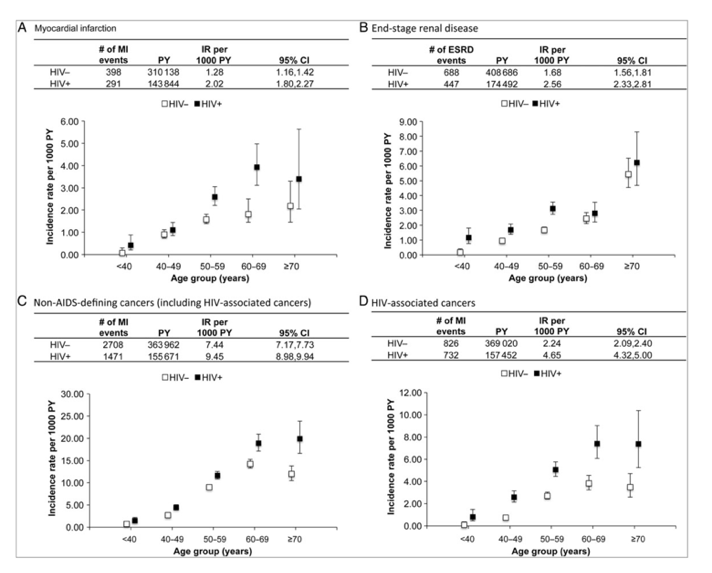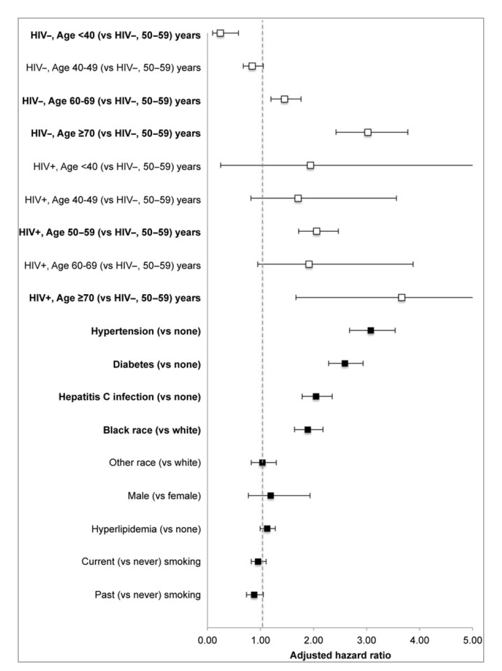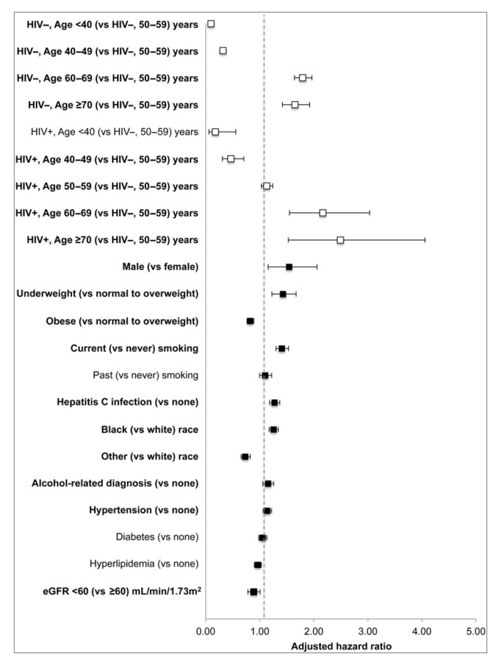| |
Advancing Age Past 65-70 & Comorbidities, Risk Factors - Comparison of Risk and Age at Diagnosis of Myocardial Infarction, End-Stage Renal Disease, and Non-AIDS-Defining Cancer in HIV-Infected Versus Uninfected Adults
|
| |
| |
Download the PDF here
Keri N. Althoff,1 Kathleen A. McGinnis,2 Christina M. Wyatt,3 Matthew S. Freiberg,4 Cynthia Gilbert,5 Krisann K. Oursler,6,7 David Rimland,8 Maria C. Rodriguez-Barradas,9 Robert Dubrow,10 Lesley S. Park,10 Melissa Skanderson,10
Meredith S. Shiels,11 Stephen J. Gange,1 Kelly A. Gebo,1 and Amy C. Justice10; for the Veterans Aging Cohort Study (VACS)
"Our study does, however, support previous findings of an increased risk of MI, ESRD, and NADC in HIV-infected compared to uninfected adults, although our estimates are attenuated compared to previous estimates. Our data show that HIV is a risk factor for these outcomes; however, many traditional risk factors have a similar or greater magnitude of relationship with these outcomes.....The crude IR of MI was 2.02 (95% CI, 1.80-2.27) and 1.28 (95% CI, 1.16-1.42) per 1000 person-years in HIV-infected and uninfected adults, respectively. Comparing HIV-infected with uninfected adults, the IRs were similar at age <50 years, but higher in HIV-infected adults among those age ≥50 years (Figure 1A).....There have been a number of hypotheses suggested to explain the increased risk of aging-associated disease among HIV infected adults, one of them being higher prevalence of traditional risk factors such as cigarette smoking [28], high blood pressure [29], dyslipidemia [30], oncogenic viral infections [31-33], male sex, black race, and lower socioeconomic status [34] compared with the general population. Our findings suggest that traditional risk factors do play an important and independent role in aging-associated diseases.
.....The risk of MI was also significantly higher in HIV-infected compared with uninfected adults after adjustment for confounders (aHR, 1.76 [95% CI, 1.49-2.07]) (Figure 2;see Supplementary Data for point estimates and 95% CIs). The interaction of age and HIV was not statistically significant in mul-tivariate Cox proportional hazards models (P =.086). Factors with a greater magnitude of association than HIV included male sex, diabetes, hyperlipidemia, and eGFR <60 mL/mi-nute/1.73 m2.
The crude NADC IR per 1000 person-years was 9.45 (95%CI, 8.98-9.94) in HIV-infected and 7.44 (95% CI, 7.17-7.73) in uninfected adults; rates of HIV-associated cancers were 4.65 (95% CI, 4.32-5.00) and 2.24 (95% CI, 2.09-2.40) per 1000 person-years, respectively. Similar to MI IRs, NADC rates show a greater rate among HIV-infected adults at all ages, with more pronounced differences in older ages (Fig-ure 1C); this was driven by the HIV-associated cancers (Figure 1D).
In multivariate Cox proportional hazards models, HIV modified the effect of age on NADC (P for interaction = .034; Fig-ure 4; see Supplementary Data for stratified analyses). Factors with a similar magnitude of effect as HIV and age included male sex, current smoking status, and BMI.

Figure 3. Adjusted hazard ratios (aHRs) and 95% confidence intervals (CIs) for end-stage renal disease, by human immunodeficiency virus (HIV) status, Veterans Aging Cohort Study Virtual Cohort, April 2003-December 2010. Bold signifies statistically significant relationships with the outcome. aHRs and 95% CIs were estimated using Cox proportional hazards models.

Figure 4. Adjusted hazard ratios (aHRs) and 95% confidence intervals (CIs) for non-AIDS-defining cancers (including human immunodeficiency virus [HIV]-associated cancers), by HIV status, Veterans Aging Cohort Study Virtual Cohort, April 2003-December 2010. Bold signifies statistically significant relation-ships with the outcome.

DISCUSSION
This study answers 2 important questions in the field of aging with HIV: compared with demographically and behaviorally similar uninfected adults, are those with HIV (1) likely to devel-op aging-associated diseases at younger ages and (2) at greater risk for these diseases? Contrary to some previous studies con-cluding a dramatically younger age at diagnosis for MI and cancer, we found no clinically meaningful difference in the age at diagnoses for MI, ESRD, and NADC after controlling for differences in age distribution by HIV status and other important risk factors. Our study does, however, support previous findings of an increased risk of MI, ESRD, and NADC in HIV-infected compared to uninfected adults, although our estimates are attenuated compared to previous estimates.Our data show that HIV is a risk factor for these outcomes; however, many traditional risk factors have a similar or greater magnitude of relationship with these outcomes. With respect to the validated, clinically relevant diagnoses of MI, ESRD, and NADC, our results support accentuated, not accelerated, aging in HIV-infected adults compared with similar uninfected adults after employing a consistent analytic approach and appropriate adjustment for confounding.
There have been a number of hypotheses suggested to explain the increased risk of aging-associated disease among HIV in-fected adults, one of them being higher prevalence of traditional risk factors such as cigarette smoking [28], high blood pressure [29], dyslipidemia [30], oncogenic viral infections [31-33], male sex, black race, and lower socioeconomic status [34] compared with the general population. Our findings suggest that traditional risk factors do play an important and independent role in aging-associated diseases. Many traditional risk factors were associated with a greater magnitude of risk compared with HIV in multivariate models. Targeting traditional risk fac-tors may help decrease the excess burden of aging-related diseases among HIV-infected adults. Studies to estimate the proportion of these outcomes avoided with reduction of these risk factors, and intervention studies that estimate the reduction of these outcomes due to reduction of these risk factors, are needed to inform interventions.
Other causes of comorbidities in HIV-infected adults include HIV itself or ART. We did not attempt to differentiate a treated vs nontreated HIV relationship in this study; however, univariate relationships of ART regimen classes used at baseline were statistically significantly associated with the outcomes of interest (Supplementary Data).
Whether increased risk of these age-associated diseases should lead to increased screening among HIV-infected adults is not a simple determination. The decision to screen and treat must balance potential benefits from early diagnosis and treatment and potential harms from diagnostic tests and treatment toxicity. Whereas increased risk of a condition often increases the potential benefit to screening and treatment, it only does so when risks from screening and potential toxicity from additional treatment are not also proportionately increased [35]. However, we find no conclusive evidence to suggest that screening for these aging-associated outcomes should occur at younger ages in HIV-infected compared with uninfected adults.
|
|
| |
| |
|
|
|